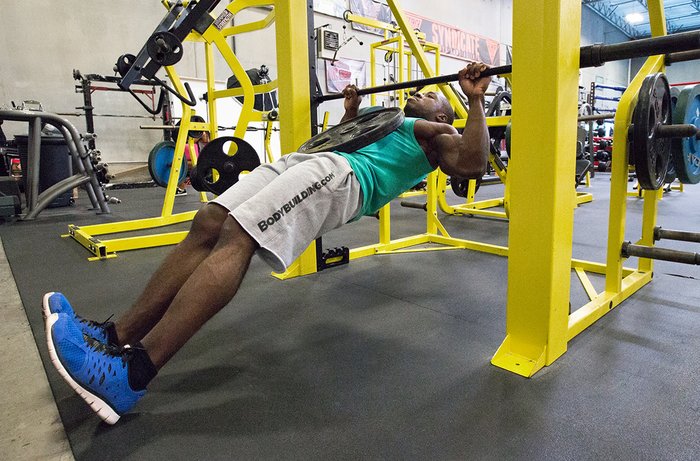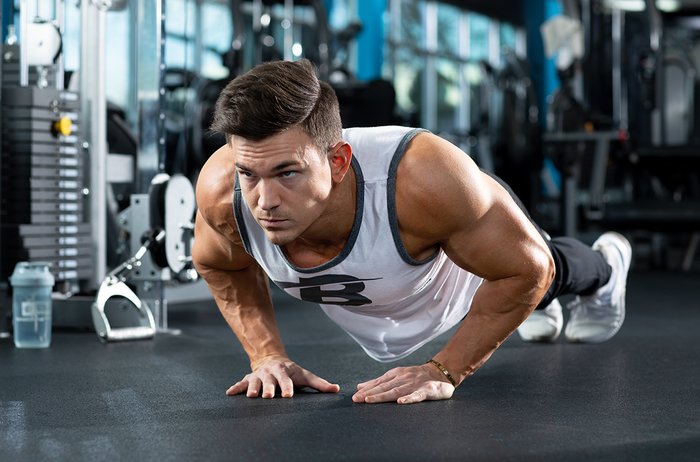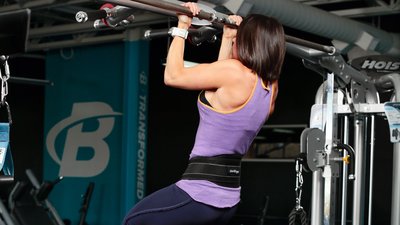Plenty of lifters use bodyweight exercises for high reps to add extra volume to a training program with minimal joint stress. And there's a ton of benefit to this! But it's definitely not the only way to train them.
With moves like push-ups, rows, and chins, you generally are moving through a large, natural range of motion, with a low risk of injury, so you can push the envelope a bit closer to failure. In the case of push-ups in particular, adding 1-3 sets of max reps at the end of an upper-body session is a perfect way to get a skin-splitting pump that won't negatively impact your recovery.
With that said, there's no reason you can't take the strengths of these movements and use them to start building, well, strength! Here are four exercises that you've probably been doing with body weight only, but that could easily be loaded up with extra weight and treated as main-course strength moves.
1. Inverted Row
Inverted rows are great for strengthening your lats, upper back, and rear delts while being easy on your shoulders. The only problem is that you run out of room to progress these pretty quickly with body weight. You can elevate your feet, but after that you're just perpetually adding sets and reps to keep overloading them, or more commonly, you discard them altogether for a more challenging movement.

The solution: Add a weight vest to your upper body, or a sandbag across the hips, and turn these into a legitimate mass builder while maintaining their shoulder-friendly status. No, inverted rows will never be conducive to ultra-low, max-effort reps, but loading them up for 2-3 hard sets of 8-12 is a great option.
2. Single-Leg Squat
Single-leg squats of all varieties need be a staple in your training. Rear-foot elevated split squats, front-foot elevated split squats, flat-ground split squats, pistol squats to a bench or standing on a box—they're all great. Not only will you strengthen your glutes, quads, adductors, and hamstrings, but you'll get to take advantage of what is known as the "bilateral deficit," namely, that the total strength of each leg worked individually exceeds what you can do when they work together. Sounds like a great opportunity for building strength to me!
The biggest issue with traditionally bodyweight single-leg squats like pistols is that when fatigue sets in, technique starts to break down. This makes high-rep sets offer more risk than reward.
The answer: First, do your single-leg squats to a box. I like having people slowly build their strength on these by increasing the depth, and when they start squatting to a 12-inch box or step, then we start adding load in the way of sandbags or a weighted vest for sets of 5-8. This shortened, heavier set will ensure each rep is rock solid, while also giving you a serious strength stimulus from the added load. Don't forget: More strength creates the opportunity for more muscle.
3. Push-up
Push-ups and all of their glorious variations are crucial to building size and keeping your shoulders healthy. But don't shortchange them by only focusing on those benefits! When loaded sufficiently, push-ups can also play a huge role as a strength builder and assistance exercise to your bench and overhead press.
Here's where they're so special: On pressing exercises when you have your back on a bench or the floor, your shoulder blades should be pulled down and pinched together. This gives your shoulder girdle the stability necessary to handle big weights. The flip side is that it locks your shoulders into a more fixed position, almost like a machine.

Push-ups allow the scapulae to move more freely, allowing a more natural shoulder rhythm. So with a more natural movement, you can load them effectively for big strength gains. Instead of pumping out sets of 20-30 reps, use a band, plate, or sandbag to load them for heavier sets of 10ish.
Like with inverted rows, super-low reps don't make sense. Sorry, I really don't care what your 1RM on the weighted push-up is, and you shouldn't either. But these absolutely shouldn't be relegated to only pump work or warm-ups!
4. Chin-up
The issue most people have with chin-ups is that they progress them only for reps, not load. For optimal shoulder health, I'm a believer that your chin-up (body weight + external load) to bench press loading ratio should be 1-1. So if you're benching 225 and weigh 180, you should be able to do a chin-up with a 45-pound plate hanging from a dip belt.
That's seriously heavy! And you don't with the intention of building strength, you're never going to get there. Besides leaving strength and your shoulder health on the table, you'll be leaving a whole lot of muscular development, as well. Use a dip belt or weighted vest, load these for sets of 3-8, and strive to increase your weights just like you would on more traditional strength movements like squats or presses.
Want even more bang for your buck? Do these on rings rather than on a bar. Chins on gymnastic rings are, in my experience, the best chins, for the simple reason that they allow for a more natural rotation of your shoulders. This allows you to use the right muscles the right way at the right time, leading to more strength, a bigger back, and less joint risk.
Just a warning, though: Ring chin-ups are more difficult at first! But stick with them, and you'll catch up to where you were on a straight or neutral-grip bar soon enough.
For all of these movements, remember that strength training is predicated on progressive overload, focused on multijoint movements that recruit a lot of muscle. While many people have developed impressive physiques and serious strength with sheer volume of bodyweight calisthenics alone, for most people, loading them up—at least some of the time—and treating them like more traditional strength training movements can help push your strength and muscle progress while keeping the joints healthy and resilient.
Want a hybrid fitness program that delivers strength, conditioning, and overall athleticism? Check out elite strength coach Nick Tumminello’s True Muscle: 9 Weeks to Elite Fitness, only on Bodybuilding.com BodyFit Elite.

